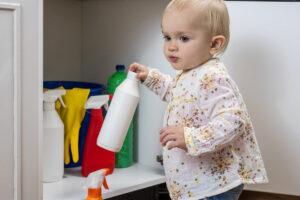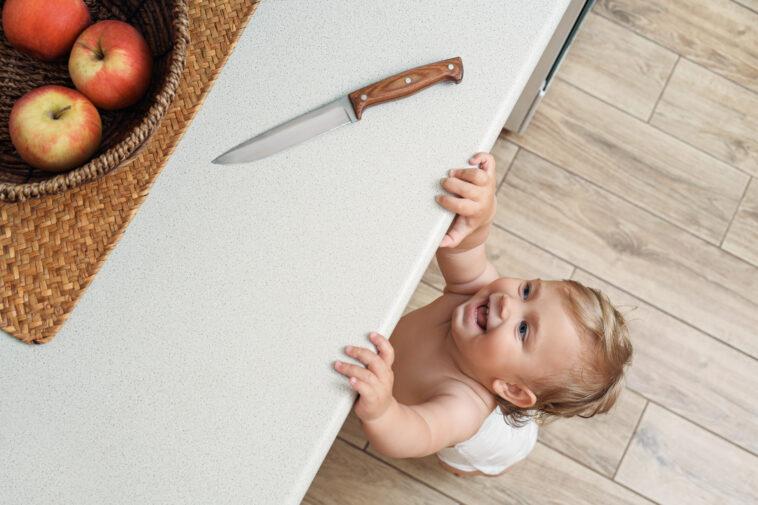Preparing for Babyproofing
You read all the parenting books to prepare for your child’s birth, and now it’s time to “baby/toddler proof” your home. With all the scary stories about the dangerous things that can hurt your little one, you may not know what to do.
First, take a deep breath and know that baby-proofing your home, while important, doesn’t have to be stressful. You can get help from a professional, do it yourself, or do a bit of both. Once you’ve educated yourself and taken the appropriate precautions, you and your growing child should be just fine.
Professional Certification for Child Safety
The International Association for Child Safety (IAFCS) has developed the childproofing industry’s first and only professional certification program. The Certified Professional Childproofer (CPC) designation recognizes those professionals who, through testing and client interaction, have proven to possess the broad knowledge and experience required for certification.
General Safety Measures
According to Daniel Leeds, a CPC in Tampa, the No. 1 thing to help protect your child isn’t anything you need to install—it’s you! Leeds reminds his clients to stay vigilant and keep an eye on their children.
Never leave your child supervised by another child or awake and alone, even if it’s only for a short time. As for how to baby-proof your house, his checklist varies depending on the family, the child or children in the home and their ages. But to start, here are a few things to consider:
Sleeping and Changing Area Safety
Blankets, Soft Toys: Keep out of the crib. Use a sleep sack or secured swaddler. Hand-knitted blankets could unravel, exposing a long, dangerous string. Other blankets are a suffocation risk.
Cribs/Beds: Check that your crib has not been recalled; some older models have hazards associated with the drop-side mechanisms. Select cribs that meet current safety standards.
Changing Tables: Never leave a child unattended on a changing table (at any age). Ensure your baby can’t reach wall hangings, cords, diaper supplies or ointments.
Smoke Detectors, Medicine and Household Cleaner Safety
Carbon Monoxide and Smoke Detectors: You should have these inside or directly outside your child’s bedroom and throughout your house. Remember to change the batteries. Orlando Fire Department recommends checking your smoke and carbon monoxide detector every year.
Medicines, Household Cleaners, Poisons, Etc.: Keep all dangerous cleaners and medications secured. Button batteries found in household items such as bathroom scales, clocks, and remotes are a severe hazard.

Windows and Doors Safety
Windows: A window stop prevents the window from opening more than a few inches. Even if windows are above a child’s normal reach, a child might move a chair or toy to reach a window.
Window Blinds/Curtains: Curtains and blinds with cords are a strangulation hazard. Use cordless window treatments.
Doors and Accordion Closet Doors: You may want to get door hinge protectors to help prevent severe injuries to little fingers.
Doorstops: The tiny rubber cap on many door stops is a choking hazard. There are one-piece door stops that do not come apart.
Electrical Safety
Electrical Cords: Keep all electrical cords in the nursery or child’s room to a minimum, and whatever is necessary, secure all cables and keep them out of the child’s reach. Don’t place baby video monitors in the crib. Anything with cords should be at least 3 feet from your baby’s crib.
Electrical Outlets: Use sliding electrical covers. Small removable outlet caps often aren’t replaced when the outlet is used and could be removed by toddlers. These small caps can be choking hazards.
Extension cords: Use surge protectors with safety covers instead.
Plugs: If an electrical item is plugged in all the time, use a “box cover” type of outlet cover to secure the plug.
Furniture and Appliance Safety
Even heavy furniture and appliances (such as a stove) can become unstable if the doors or drawers are opened, pulled or climbed on. Use appropriate anchoring or tethering devices to ensure all appliances are securely fastened with screws into wall studs. Keep furniture, including the crib/bed, away from windows; this helps prevent toddlers from climbing near windows. Also, a dresser near the crib/bed could provide a foothold for climbing, leading to falling or being trapped between the dresser and the bed/crib.
Step Stools and Child-Sized Chairs: Keep these secured and used only under supervision. Children often use them to gain access to items that are stored up high or windows. Some of them are unstable or designed for older children.
Front Loading Washing Machines/Dryers: Children can become trapped inside. Keep doors shut and locked when not in use.
Kitchen Appliances: Keep kitchen appliances in locked cabinets and oven door locked at all times. Use knob locks on the stove.
Lamps: Overhead lighting is best since toddlers or pets can pull over free-standing or table lamps.
Weapon Safety
Guns or Other Weapons: Keep these in lock boxes made for weapon security. Biometric gun safes are especially helpful.
Water Safety
Pools/Hot Tubs: Have four-sided, four-foot or taller fencing around pools, hot tubs, spas, and other water features such as fountains, ponds and waterfalls.
Play Equipment Safety
Toy Chests: Newer toy chests usually have lid supports and no locking features. Older trunks may not. Ensure the lid and the lock (if there is one) can be opened from the inside of any toy chest.
While this is not a complete list of all the areas and items in your home, it’s a good checklist to get you started. If you want to save time and have more peace of mind, look for childproofing services in your area. You can also consult the Consumer Product Safety Commission’s website, cpsc.gov, for safety recalls on specific products.



Comments